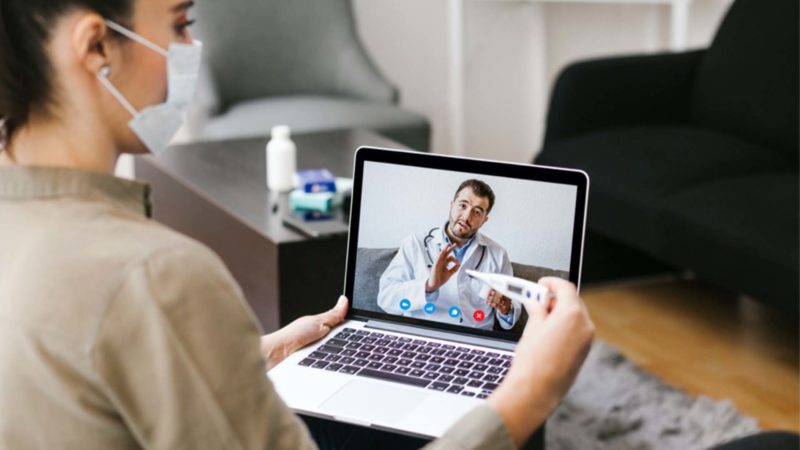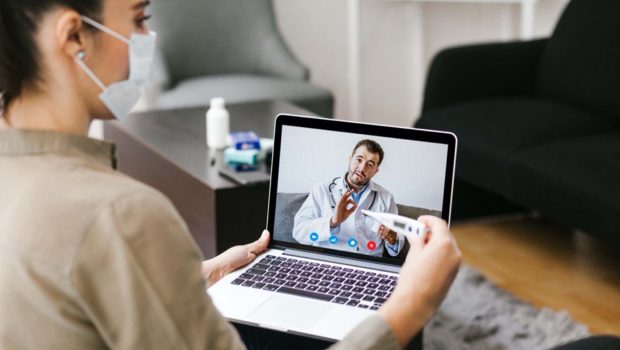Telemedicine points to increasing role of technology in health care delivery
If there’s one application of technology that may be a lasting legacy of the pandemic, it is the use of videoconferencing to connect people, whether in business or in accessing health care.
The use of telemedicine during the COVID-19 crisis points to the increasing role technology will play in health care not only in treatments but in how those treatments are delivered, according to health care professionals with Bon Secours and Prisma Health.
A new normal
For Dr. Steven Newman, a family medicine physician with Bon Secours, telehealth was a game changer during the height of the pandemic.
To illustrate the magnitude of the change, he says prior to the pandemic within the Bon Secours system only about 2%-3% of primary care visits were conducted virtually through telemedicine. By contrast, that figure rose to near 100% for several weeks at the height of COVID restrictions and now has settled down to a rate of between 15%-20%.
“The virtual visit really saved the patient-doctor relationship during that transition when COVID was unknown, when we didn’t know how infectious it was,” Newman says. “The value of it was recognized immediately.”
More than two years after the start of the pandemic, the technology has become a mainstay in health care delivery, but the challenge going forward is recognizing telemedicine’s limitations. Due to the virtual nature of the interaction, medical staff are limited to non-physical examinations.
“A lot of (technology development) is going to be consumer driven, but a lot of it’s going to be an increasing demand on a decreasing availability to see a doctor.” Dr. Steven Newman, Bon Secours family medicine physician
“You can’t diagnose everything either via a video visit or a telephone conversation,” Newman says.
While many diagnoses require physical exams, there are also many that don’t, he adds. This means the experience and judgment of the provider will necessarily have to supersede the convenience telemedicine provides.
Other limitations include the difficulty some patients have in using the technology required for a virtual visit, according to Newman, whether that be from unfamiliarity with the devices or due to visual or hearing impairments.
Newman also echoes concerns raised within the business community regarding virtual meetings, namely that in virtual meetings, participants lose some of that personal connection that happens in face-to-face meetings.
“To me, as a family practitioner, that doctor-patient relationship is sacred,” he says.
Despite telemedicine’s limitations, Newman says it will continue to be an important tool in improving health care access. But he sees telehealth as just one part of how health care providers are using technology to both improve the quality of care and expand access to that care.
“I’m personally very excited about what technology is probably going to do for us in the next five to 10 years in regards to at-home monitoring and health care,” he says.
Extending expertise
Using technology to coordinate in-home care is precisely what Prisma Health’s Home Recovery Care program is all about.
The program connects in-home care teams with acute care specialists to provide a level of care that would have previously required a hospital stay, according to Angela Orsky, vice president of value-based care and clinical integration with Prisma Health.
“It’s almost as if (the physician is) in the room doing his physical exam,” she says.
The program is much more than remote monitoring of a patient’s vital signs. Through tools like a “virtual stethoscope” and other medical devices, the home health team sends real-time data to the physician overseeing the patient’s recovery.
“It brings good triage,” Orsky says. “It brings good real-time assessment.”
Orsky adds the in-home aspect of this approach also affords the medical team the ability to assess potential risks in the home that may hamper recovery. For example, nurses can ensure the patient is taking the proper medications at the proper time and — equally importantly — not taking medications that the physician has advised them to discontinue.
Orsky says patients routinely report feeling comfortable with the technology, especially when it allows them to recover in their own homes. This ability to recover in familiar surroundings is especially important with older patients.
“We hear our patients say that they feel like their recovery is much quicker,” Orsky says.
Prisma is also using remote monitoring technology in a clinical setting through its virtual intensive care unit program. That program has allowed expanded ICU capabilities at Oconee Memorial Hospital and Easley Baptist Hospital, thus expanding the reach of ICU specialists to some of the system’s smaller regional facilities.
Aside from increasing the efficiency of a scarce resource — highly trained medical specialists — the virtual ICU program expands the high level of care to more patients.
This leads to shorter stays for what are typically the sickest patients, and that in turn reduces costs, according to Amelia Gainey, director of digital health services with Prisma Health.
“These remote teams and physicians can literally do everything short of a procedure,” she says. “Virtual care is here to stay, especially as people become more familiar with the technology.”

Empowering patients
Technology is not just transforming health care from the side of providers but is increasingly providing more options for patients.
Anderson-based Sync.MD has pioneered a secure mobile app that empowers patients to have complete control over their medical records, which gives patients a freedom and control that until recently was mostly theoretical.
The problem, as founder and CEO Eugene Luskin describes it, is that due to the extreme level of regulation in the health care industry, there is an “insane level of fragmentation” in how medical records are generated, especially if a patient changes providers.
“Virtual care is here to stay, especially as people become more familiar with the technology.” Amelia Gainey, director of digital health services for Prisma Health
But according to federal law, most recently the 21st Century Cures Act implemented in 2021, patients have a right to their medical records free of charge. By focusing on the patient and providing them with a secure “personal electronic briefcase,” SYNC.MD’s mobile app gives patients a much greater level of control over their health records and who has access to them, Luskin says.
“What’s important is that (the records) are now linked to this one human being,” he says.
Luskin adds that it’s important to understand his company’s app is not in competition with electronic records systems maintained by hospitals and other health care providers and should not be confused with those systems.
“We’re providing a service to the patient to have an ability to collect data, store it and share it,” he says. “It’s patient-centric in true form.”
Key terms:
Telehealth/telemedicine — This is the use of technology to virtually connect patients with health care providers, typically using the audio and video connections of a smartphone, tablet or computer.








Gloss